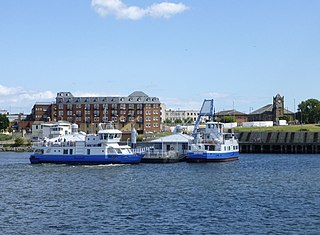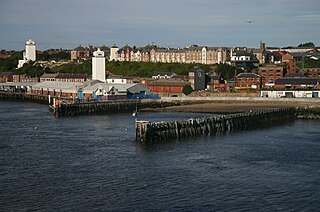
North East England is one of nine official regions of England at the first level of ITL for statistical purposes. The region covers an area of 8,592 km2 and in 2019 had a recorded population of nearly 2.7 million. There are four counties in the region: County Durham; Tyne and Wear; Northumberland and part of North Yorkshire. The largest settlements are Newcastle upon Tyne, Middlesbrough, Sunderland, Gateshead and Darlington. There are three conurbations in the region: Tyneside ; Wearside ; and Teesside. Only three settlements in the region have city status: Newcastle upon Tyne, Sunderland and Durham.

Tyne and Wear is a metropolitan county in North East England, situated around the mouths of the rivers Tyne and Wear. It came into existence in 1974 after the passage of the Local Government Act 1972, which also created the five metropolitan boroughs of Newcastle upon Tyne, Gateshead, North Tyneside, South Tyneside and the City of Sunderland which constitute the county. It is bordered by Northumberland to the north and Durham to the south. Prior to the 1974 reforms, the area now covered by Tyne and Wear was split between the counties of Northumberland and Durham, the border being marked by the River Tyne. The county no longer has any local government powers, following the disbanding of Tyne and Wear County Council, so the county only exists for ceremonial purposes.

Wallsend, historically Wallsend on Tyne, is a town in North Tyneside, England. It derives its name from its location at the eastern end of Hadrian's Wall. It has a population of 43,842 and lies 3.5 miles east of Newcastle upon Tyne.

South Tyneside is a metropolitan borough in the metropolitan county of Tyne and Wear, North East England.

North Tyneside is a metropolitan borough in the metropolitan county of Tyne and Wear, England. It forms part of the greater Tyneside conurbation. North Tyneside Council is headquartered at Cobalt Park, Wallsend.

South Shields is a coastal town in South Tyneside, Tyne and Wear. It is situated at the south of the River Tyne. Historically, it was known to Romans as Arbeia and as Caer Urfa by Early Middle Ages. According to the 2011 census, the town had a population of 75,337. It is the fourth largest settlement in Tyne and Wear; after Newcastle upon Tyne, Sunderland and Gateshead. It is roughly equidistant (approximately 3.7 miles between the border of Newcastle and the border of Sunderland.

Tynemouth is a large coastal town and former county borough in the metropolitan borough of North Tyneside in North East England. It is located on the north side of the mouth of the River Tyne, hence its name. Historically part of Northumberland, it is now part of the wider Tyneside conurbation and is best known for Tynemouth Castle and Priory.

North Shields is a coastal town on the north bank of the River Tyne in the North Tyneside borough in Tyne and Wear, North East England. North Shields is 8 miles(13 km) north-east of Newcastle upon Tyne. The town's name derives from Middle English schele meaning "temporary sheds or huts used by fishermen". Historically North Shields was part of the Tynemouth County Borough in Northumberland until 1974, when it became part of Tyne and Wear.

North Shields Fish Quay is a fishing port located close to the mouth of the River Tyne, in North Shields, Tyne and Wear, North East England, 8 miles (13 km) east of the city of Newcastle upon Tyne.

The Shields Ferry operates across the River Tyne, between North Shields and South Shields in Tyne and Wear, England. The service is operated by the Tyne and Wear PTE. Prior to takeover by the PTE in 1972, it was known as the Market Place Ferry.
The North Tyneside Loop refers to the railway lines in North Tyneside from Newcastle upon Tyne via Wallsend, North Shields, Whitley Bay, Backworth, Benton and South Gosforth back to Newcastle. Since the 1980s, it has formed part of the Tyne and Wear Metro, albeit in modified form.

Howdon is a largely residential area in the eastern part of Wallsend, Tyne and Wear, England. It consists of High Howdon and the smaller settlement of East Howdon. Much of the High Howdon area was formerly called Willington prior to post-World War II urbanisation. The North Tyneside ward population at the 2011 Census was 11,129.
Willington Quay is an area in the borough of North Tyneside in Tyne and Wear in northern England. It is situated on the north bank of the River Tyne, facing Jarrow, and between Wallsend and North Shields. It is served by the Howdon Metro station in Howdon. The area from 2006 onwards has been an area of new housing built on brownfield sites. The house building continues into 2013 and is changing the social and economic balance in the area. The area has also had a make over of the bowling green off Howdon Lane and further warehousing next to the bowling green has been demolished to make way for further new housing. The changes made recently at Willington Quay are now making it an attractive place to live within North Tyneside.

Tynemouth is a Tyne and Wear Metro station, serving the coastal town of Tynemouth, North Tyneside in Tyne and Wear, England. It joined the network as a terminus station on 11 August 1980, following the opening of the first phase of the network, between Haymarket and Tynemouth via Four Lane Ends.

Whitley Bay is a Tyne and Wear Metro station, serving the coastal town of Whitley Bay, North Tyneside in Tyne and Wear, England. It joined the network on 11 August 1980, following the opening of the first phase of the network, between Haymarket and Tynemouth via Four Lane Ends.

Tyne and Wear Fire and Rescue Service, formerly known as the Tyne and Wear Metropolitan Fire Brigade, is the fire and rescue service (FRS) for the metropolitan boroughs of Newcastle Upon Tyne, Gateshead, North Tyneside, South Tyneside and Sunderland, serving a population of 1.14 million people across an area of 208 square miles (540 km2). Tyne and Wear Fire and Rescue Authority is responsible for the running of the service, as well as the publication of performance indicators in accordance with its legal obligations. In April 2017, Chris Lowther was appointed chief fire officer.
The Tynemouth Volunteer Artillery claims to be the oldest volunteer artillery unit of the British Army. It served coastal and siege guns in World War I and World War II, and also served in the infantry role.

The High and Low Lights of North Shields are decommissioned leading lights in North Shields, Tyne and Wear in the United Kingdom. Two pairs of lights survive: the older pair date from 1727 and were operational until 1810; the newer pair then took over, remaining in use until 1999. All four are listed buildings. They were sometimes known as the Fish Quay High and Low Lights, or as 'Fish Quay ' and 'Dockwray Square '.
The Tyne Electrical Engineers (TEE) is a Volunteer unit of the British Army that has existed under various titles since 1860. It has been the parent unit for a large number of units fulfilling specialist coastal and air defence roles in the Royal Engineers (RE) and Royal Artillery (RA), many seeing service during both World Wars. TEE companies currently form part of the RE and of the Royal Electrical and Mechanical Engineers in the Army Reserve.
Percy Main is a small village absorbed into North Shields, North East England. Historically in Northumberland, it is now part of Tyne and Wear.


















